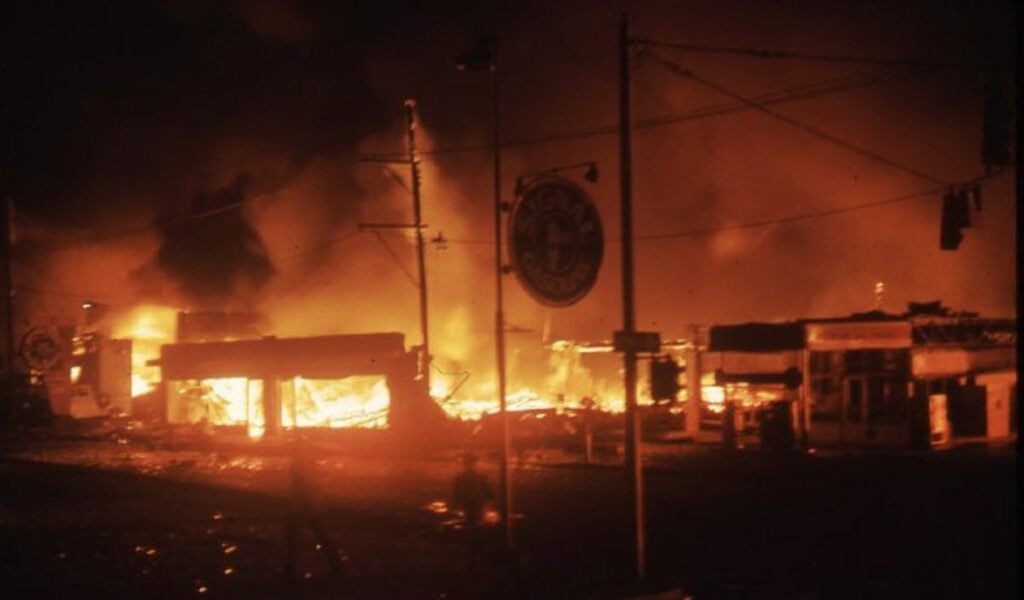Sixty three years ago, on August 7, 1959, I was 12 years old and something really bad happened in my sleepy little lumber town. Around one a.m. in the wee hours of a sweltering summer night the big siren over the fire station five blocks away from our house went off and woke me up. It was loud enough that you could hear it for miles, and was how volunteer firemen were summoned in an emergency.
Because it was a hot night the French windows in my bedroom were open. I perched up on the sill to see what was going on. From our house on the hill I could see a big fire a few blocks away in downtown Roseburg. This was not a drill. It appeared that the Gerretsen Building Supply store was ablaze, and flames were shooting into the air.
Moments later there was a blinding flash, then a huge explosion. The concussion that followed a couple of seconds later blew me across the room and into the wall. It knocked out all the glass in our house except for my windows that were open. I scrambled back to my vantage point and witnessed what looked like a mushroom-shaped cloud from an atom bomb detonation.
Pieces of burning wood from the warehouse rained down across the town and some of the fiery debris set the dry field behind our place ablaze. This was by far the most exciting thing I had experienced so far in my young life. It never occurred to me that I could have been killed. My dad ran into the room shouting that we had to get out of there. He said something about being under attack by the Russians. (Worth noting that this was at the height of the Cold War and “duck and cover” under your desk drills in school to save yourself from a nuclear bomb blast-good luck with that). Even at that age I thought why the hell would Russians want to attack Roseburg?
My father marshalled me, mom, and my three sisters into the living room. I remember our cat batting a broken piece of glass around. “We’re heading to my brother’s place outside of town,” he announced. “But dad,” I said, “can’t we stay?” The answer was, “Get in the car now!” Dang, no more Russian invasion for me. As we drove away from town the yellow-red light from the fire reflected off Mt. Nebo on the other side of the river. I craned around for one last look at the disaster. My parents and sisters were traumatized. I was bitterly disappointed that we had to leave.
That 1959 blast was the greatest disaster in Roseburg’s history. A Pacific Powder Company truck loaded with over six tons of ammonium nitrate and dynamite had been parked next to Gerretsen’s, and the fire caused it to blow up. Fourteen people died in the disaster. The junior high school that I was supposed to attend the following year was right across the street from ground zero and was ruined. When the truck exploded it made a crater over fifty feet in diameter and twenty feet deep. The fireball created by the explosion went 500 feet in the air, hence the mushroom cloud effect. Windows were broken more than eight miles away. People in the surrounding towns thought they were experiencing an earthquake.
In an excellent recap of the event, David Tishendorf, former managing editor of The Roseburg News-Review wrote, “The truck itself disappeared. Only two pieces of it were ever found: the front axle was blown through the air, struck once four blocks away, gouged a hole in the pavement, bounced back into the air, struck a tree, bounced back 50 feet and came to rest in front of the Greyhound bus depot; the spindle went crashing through Long and Orr Mortuary.
Buildings were flattened, as if a giant hand had swatted them aside; chimneys were wrenched from houses; walls swayed, buckled and fell. Power lines snapped, windows shattered, spraying glass fragments; foundations were shifted. Cars were slammed violently about. The massive rush of air carried bricks, metal fragments, glass and other debris in a deadly shotgun-like blast. A nearby Coca-Cola bottling plant was destroyed. Bottles exploded like machinegun bursts . . .
The blast picked up a police patrol car containing two Roseburg patrolmen and blew it 100 feet through the air. The patrolmen walked away with minor injuries. The final toll would be 14 killed, 125 injured, and 350 buildings damaged over a 50-block area . . . But the night was not over. Heat and flying brands from the explosion set off fires in a seven-block area destroying dozens of buildings.”
The giant explosion in Beirut almost exactly 61 years later on August 4, 2020, was caused by 2,700 tons of ammonium nitrate blowing up. That blast was over 700 times bigger than the Roseburg event. Hard to imagine. I found this photo from the following day in my town, you can see the crater at the right. I luckily escaped unharmed, and it proved to be good training for my later career, at least to the degree that my dad never again made me leave the scene of a good story!

